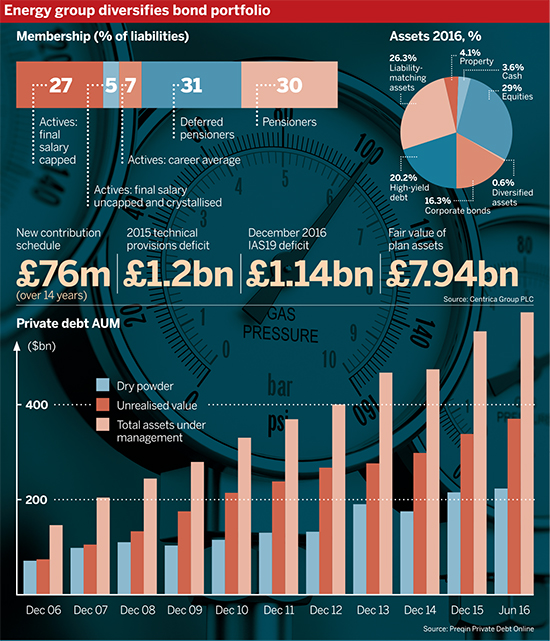The Centrica Combined Common Investment Fund, which manages holdings for the energy giant’s pension schemes, has trimmed its exposure to corporate bonds, reweighting its portfolio towards high-yield debt.
The parent of British Gas also agreed a new triennial valuation and additional asset-backed contributions worth £76m a year with its schemes.
Last year saw compressed bond yields across the credit spectrum, owing to a range of political and economic factors. In response, many schemes have begun to diversify their fixed income portfolios and seek out higher yields.
What we're seeking to do is generate higher returns without increasing risk
David House, Centrica
Centrica’s schemes manage £7.94bn of assets, of which the majority are held by the Centrica Engineers Pension Scheme, Centrica Pension Plan and Centrica Pension Scheme.
Yields feel the pinch
During 2016, Centrica’s schemes cut their combined allocation to corporate bonds to £1.29bn from £1.73bn, representing 16.3 per cent of the total assets at the end of the year.
Meanwhile, the £948m high-yield debt allocation was lifted to £1.61bn, or 20.22 per cent of the total assets.
The investment includes traditional high yield, senior loans and private debt, and the vehicle has an ongoing programme to increase the allocation to private debt.

Explaining the decision, David House, deputy group HR director at Centrica, said the drop in corporate bond yields was a key driver: “That universe got to pretty low yields... after the Brexit vote and we’ve used that as an opportunity to reduce the corporate bond allocation.”
Check your strategy
High-yield debt can offer diversification benefits. Adrian Hull, senior fixed income investment specialist at Kames Capital, said: “Long-term studies show that high-yield markets are not correlated to the US rates markets – this might be a useful diversification for the bond element of the scheme.”
Moving into higher-yielding assets can imply increased credit risk, with companies more likely to fail. Andy Burgess, fixed income product specialist at Insight Investment, recommended cutting duration in response.
“Investing in short-dated high yield can result in a superior risk-reward profile and a lower risk of defaults overall, while still offering the potential for higher returns,” he said.
Whatever the strategy, Simon Cohen, head of investment consulting at Spence & Partners, recommended schemes pay close attention to performance-related fees, which he said should only be applicable to outperformance of Libor plus a margin, rather than merely beating a benchmark.
New funding arrangement
Low bond yields also had an impact on the Centrica schemes’ funding position. The group’s accounting deficit swung to £1.14bn in December 2016 from just £119m at the end of 2015.
House said a similar movement could be seen in the schemes’ actuarial deficits, as the assets are largely unhedged against interest rate risk and invested for growth.
“Our liabilities are long-dated compared to the market average, and as a result the effects of that movement in the discount rate are amplified in our situation compared to schemes that are shorter term,” he said.
All three significant schemes have active members, although only the career average section of the CEPS remains open to new members.
Centrica commits £300m to unleveraged infrastructure equity

Unleveraged infrastructure is a growing part of Centrica Pension Scheme’s portfolio as the fund seeks to access long-term, stable cash flows, but others warn about the regulatory risk associated with the asset class.
In response to actuarial valuations finalised during the year, Centrica agreed to a renewed asset-backed funding promise of 14 yearly payments worth £76m from 2017 onwards. The new commitment, alongside previous scheduled contributions, is supported by a £995m security package covering certain Centrica assets.
Asset-backed funding is a useful tool for trustees, especially where an employer could pay off a deficit faster but wants to use capital for other things, said Stuart O’Brien, partner at law firm Sackers.
O’Brien said employers are often put off funding deficits over shorter periods because of the difficulty recovering surpluses in the event liabilities shrink.
But he did not see a clear case for relaxation of the rules around this, saying: “It’s a very, very strict regime and with good reason, because a surplus on one measure is a deficit on another.”














